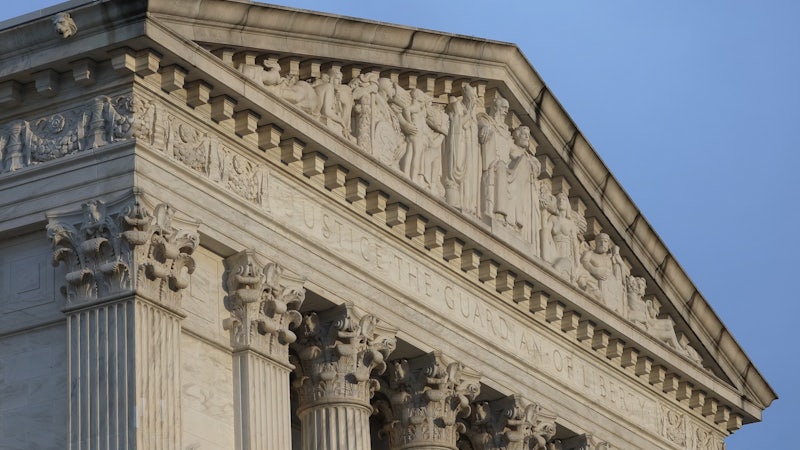The White House is at Stake for Four Years – the Supreme Court for Much Longer
Dear Reader,
Clarence Thomas will, in a few months, begin serving as a Supreme Court justice during a tenth presidential term. Thomas, who took the bench in 1991, is approaching the all-time record tenure for any Supreme Court justice, currently held by William O. Douglas, who served for over 36 years, from 1939 to 1975. If Thomas makes it to the end of the next president’s term, he’ll stand alone atop the list. Douglas’s tenure began before World War II and ended after Vietnam. Thomas started years before the internet existed, when Thurgood Marshall, Richard Nixon, Audrey Hepburn, and Mickey Mantle were still alive. He’s still going strong, by all outward appearances.
Thomas’s tenure is a reminder that, for the unimaginable power any president holds, a Supreme Court justice isn’t far behind, and can wield it for far longer. In many respects, a president’s Supreme Court nominations are his or her most important legacy.
The outcome of our presidential election – now eleven days away – will reshape the Supreme Court at a pivotal moment in its history. Let’s take a hard look at how the Court might change, depending on the outcome of the 2024 election.
At this point, there are realistically only two ways that any Supreme Court justice leaves the bench. First, the old standby, death. Second, the intentionally-timed resignation enabling appointment of an ideologically-aligned successor. Over the past few decades, we’ve seen two deaths (Antonin Scalia, eventually succeeded by Neil Gorsuch and Ruth Bader Ginsburg, succeeded by Amy Coney Barrett) and four strategic retirements (David Souter yielding to Sonia Sotomayor, John Paul Stevens to Elana Kagan, Anthony Kennedy to Brett Kavanaugh, and Stephen Breyer to Ketanji Brown Jackson).
So let’s project how the Supreme Court might look four years from now, depending on the presidential election outcome. We’ll be neither ghoulish nor squeamish about death; it happens, the chances increase with age, and we need to take the possibility into consideration. Here’s our current roster, including age.
Clarence Thomas 76
Samuel Alito 74
Sonia Sotomayor 70
John Roberts 69
Elana Kagan 64
Brett Kavanaugh 59
Neil Gorsuch 57
Ketanji Brown Jackson 54
Amy Coney Barrett 52
If Donald Trump wins, watch for the Court’s current six-to-three conservative majority to become so deeply entrenched that it’ll surely survive for the next generation or two. One or both of Thomas and Alito – both true believers in the conservative cause – could step down, surely to be replaced by new like-minded justices in their late 40s (as Barrett was at her confirmation) or early 50s (like Gorsuch and Kavanaugh were when they took the bench). That’ll cement a conservative majority until at least, say, 2050. And if Sotomayor, the oldest of the liberal justices, doesn’t make it until 2028 (god forbid, I feel obliged to say, as somebody who argued in front of her during her pre-Supreme Court days and deeply admires her), then we’re looking at a seven-to-two conservative edge, now and for a long time hence.
If Kamala Harris prevails, then Sotomayor might well decide to hang up the robe and give way to a liberal justice in her 40s or 50s. Breyer did this during the Biden years, rolling his seat over to the far-younger Jackson, and Sotomayor resisted calls from some liberals to do the same. But there’s a difference between ages 66 to 70 (as Sotomayor was during the Biden presidency) and 70 to 74 (as she’ll be during the next term).
Then we need to consider the mortality of the Court’s two oldest justices, Thomas and Alito, who’ll turn 80 and 78 by the end of the next president’s term. If (again, god forbid) one of them doesn’t make it, the six-to-three conservative Court becomes five-to-four under a Harris presidency. If both take their leave, then the Court would suddenly become five-to-four in favor of the liberals.
Of course, control of the Senate, which has confirmation power, is vital. Democrats hold a narrow 51 to 49 advantage at the moment. But leading prognosticators forecast that it’s likely, though not certain, that Republicans flip two (or more) seats and take control. If that happens, any Trump nominee would sail through. And if Republicans take the Senate while Harris wins the White House, then we’ll see whether the GOP reactivates or expands its Merrick Garland rule – the invented premise that we don’t confirm justices within some nonspecific time before the end of a president’s term. (Just flip the effects if Democrats hold their Senate advantage.)
The contrast between the two scenarios is drastic, and the consequences self-evident. If Trump wins, many of us probably won’t live long enough to see a liberal Supreme Court (again: apologies for the morbidity). And if Harris wins, there’s an outside chance the Court flips back to a liberal majority, especially if she serves two terms.
We’ll be reminded constantly over the next week and a half that the stakes of this presidential election are enormous, and they are. But while the occupant of the White House will be gone in four or eight years, the Supreme Court will be changed for decades.
Stay Informed,
Elie





























